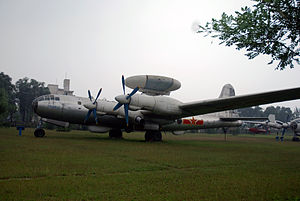KJ-1 AEWC
| KJ-1 | |
|---|---|

| |
| KJ-1 AEWC (Tu-4 with radar) at China Aviation Museum | |
| Role | Airborne Early Warning and Control |
| National origin | People's Republic of China (PRC) |
| Status | cancelled |
| Number built | 1 |
| Developed from | Tupolev Tu-4 |
The KJ-1 is a first generation Chinese AEW (Airborne Early Warning) radar fitted to a Tupolev Tu-4 bomber. The project was started in 1969 under the code name "Project 926". (KJ is from the first characters of the Pinyin spelling of 空警, (Kōng Jǐng), short for 空中预警 (Kōng Zhōng Yù Jǐng), which means Airborne Early Warning).
Design and development
According to PRC government claims, a single KJ-1 would be equivalent to more than 40 ground radar stations, but development was stopped due to the Cultural Revolution. In the era of the Chinese economic reform, the project was once again put on hold because economic development was given top priority. When the project was finally reviewed again for the modernisation of the People's Liberation Army Air Force it was considered obsolete. In the KJ-1's place PRC developed a phased-array radar for its KJ-2000 AWACS.[1] The sole KJ-1 is now on display at the PLAAF museum north of Beijing.[2]
External links
References
- ^ "Chinese Airborne Early Warning (AEW)." fas.org. Retrieved: 29 December 2009.
- ^ "Chinese Airborne Early Warning (AEW)." PLA-AF Airborne Early Warning & Control Programs.
